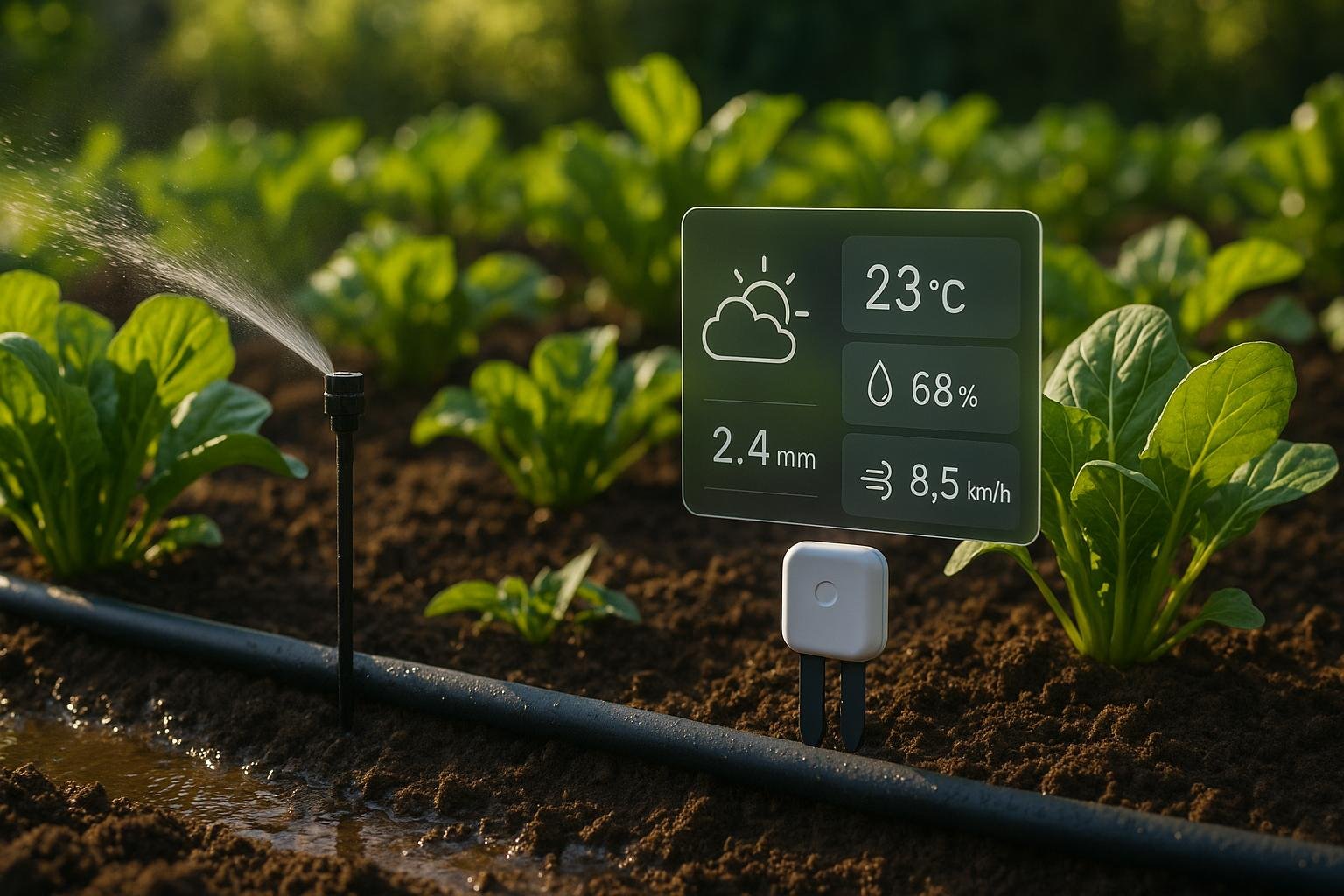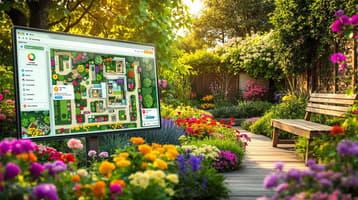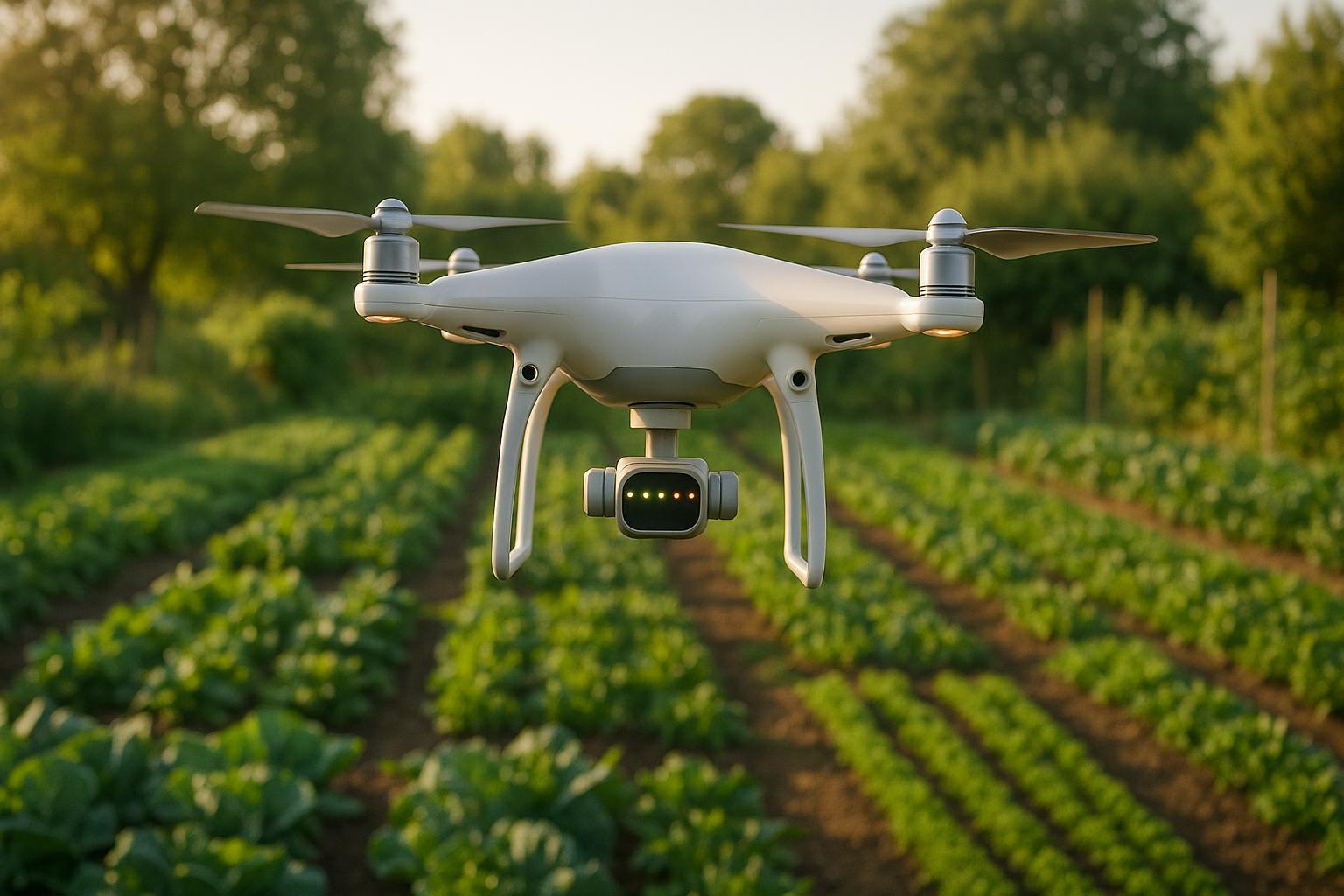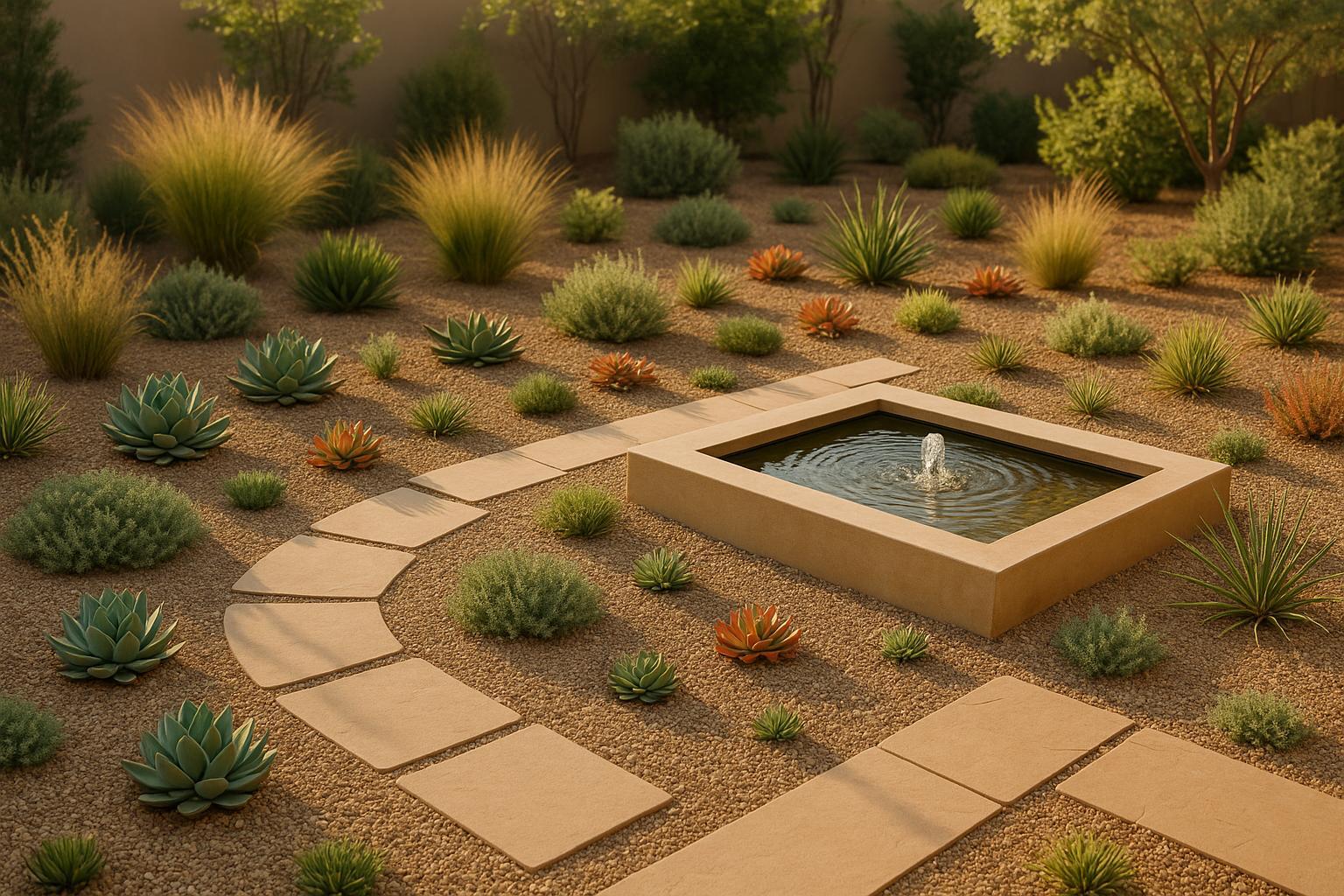How AI Analyzes Irrigation System Compatibility

AI is transforming irrigation by using data like soil moisture, weather patterns, and plant needs to create precise, water-efficient plans for gardens. It tailors watering schedules, adjusts for real-time changes like rainfall or heat, and ensures plants get the right amount of water without waste. Tools like AIGardenPlanner combine this analysis with plant recommendations based on your garden's conditions, helping you save water and grow healthier plants. With features like real-time monitoring and equipment evaluations, AI simplifies water management and supports smarter gardening practices.
AI Controlled Smart Irrigation System

Data Sources for AI Analysis
AI systems rely on diverse and detailed data to deliver precise irrigation analysis. The accuracy of these systems in matching irrigation methods to plant needs and environmental conditions depends heavily on the quality and variety of the data they process.
Key Data Inputs for AI
Soil moisture sensors are critical for real-time monitoring. These sensors measure how much water is present in the soil at various depths, providing updates every 15–30 minutes. With their ability to capture a wide range of moisture levels, they offer AI systems the exact information needed to determine when and where irrigation is required.
Weather station data plays a vital role by supplying AI with both current and forecasted weather conditions, including humidity, wind speed, and rainfall. Historical weather records, often spanning 10 to 30 years, allow AI to account for seasonal patterns and long-term climate trends specific to a given location.
Plant databases offer detailed insights into the watering needs of thousands of plant species commonly cultivated in the United States. These databases specify ideal soil moisture levels, preferred watering frequencies, and seasonal water requirements. For example, tomatoes generally need 1–2 inches of water per week, while certain native grasses thrive with as little as 0.5 inches.
Water flow rate measurements from existing irrigation systems inform AI about system capacity. Drip irrigation systems, for instance, typically deliver between 0.5 to 2 gallons per hour per emitter, while sprinkler systems might apply 1 to 2 inches of water per hour. AI uses this data to determine whether the current system can meet the specific watering needs of plants.
Soil composition analysis provides insights into how soil retains and drains water. Sandy soils, which drain quickly, may require more frequent watering, whereas clay soils retain moisture longer, necessitating careful adjustments to avoid runoff. This data helps AI fine-tune irrigation schedules and volumes.
Topographical data maps out how water moves across a landscape. Slopes, elevation changes, and natural drainage patterns all influence water distribution. AI uses this information to identify areas where irrigation adjustments are necessary to ensure even coverage.
These diverse inputs are standardized through consistent measurement units, ensuring the data remains accurate and actionable.
Measurement Standards and Units
To function effectively, AI irrigation systems align with the measurement standards commonly used in the United States. For temperature, data is processed in Fahrenheit, while precipitation is measured in inches. This standardization simplifies calculations and comparisons. Water-related data is typically converted into inches per week or month for consistency.
Pressure measurements for irrigation systems are recorded in pounds per square inch (PSI). Most residential systems operate within a range of 20 to 50 PSI, and AI uses this information to calculate optimal flow rates and distribution patterns.
Area calculations are handled in square feet for smaller gardens and acres for larger properties. AI systems can seamlessly convert between these units to analyze water distribution and coverage needs.
Flow rates are measured in gallons per minute (GPM) for larger systems or gallons per hour (GPH) for precision methods like drip irrigation. AI leverages these measurements to ensure systems deliver the right amount of water within the appropriate timeframes.
AI Methods for Evaluating Irrigation Systems
AI has revolutionized irrigation by using advanced algorithms to turn raw data into practical, easy-to-follow recommendations. By analyzing real-time sensor inputs alongside historical trends, these systems provide highly accurate irrigation guidance tailored to specific needs. Below, we’ll explore the AI models and optimization techniques that make this possible.
AI Models and Algorithms
Modern irrigation systems rely on a variety of machine learning models to fine-tune watering strategies:
- Supervised Learning Algorithms: These models are trained on diverse irrigation scenarios, enabling them to identify patterns in soil, plant, and weather conditions. As they process more data, their recommendations become increasingly refined.
- Decision Tree and Rule-Based Systems: These approaches use step-by-step logic to assess factors like soil type, plant requirements, and weather. By applying horticultural principles, they deliver precise advice while adapting to specific environmental conditions.
- Neural Networks: With their ability to detect complex relationships among variables, neural networks uncover subtle patterns that simpler models might overlook.
- Predictive Analytics: By studying historical data - such as past weather trends and seasonal plant behaviors - these models forecast future irrigation needs. This allows gardeners to plan watering schedules that account for seasonal variations.
- Clustering Algorithms: These group plants with similar watering needs, distinguishing between those that require frequent, light watering and those that thrive with deeper, less frequent sessions. This helps design efficient irrigation zones and minimizes water waste.
How AI Optimizes Irrigation Settings
AI systems continuously monitor real-time data from devices like soil moisture sensors, weather stations, and plant imaging tools to provide adaptive irrigation recommendations. Here’s how they fine-tune irrigation:
- Dynamic Adjustments: AI adapts watering schedules based on current conditions. For instance, if sensors detect sufficient soil moisture from recent rainfall, the system may delay irrigation. Conversely, during unexpected heat waves, it can increase watering frequency to prevent plant stress.
- Flow and Pressure Optimization: By analyzing factors like soil absorption, root depth, and evaporation rates, AI can recommend adjustments such as installing boosters or modifying pipe diameters to ensure water is distributed effectively.
- Seasonal Adaptation: As plants move through different growth stages, AI adjusts irrigation parameters. For example, young plants might need frequent watering to establish roots, while mature plants benefit from deeper, less frequent watering to promote stronger root systems.
- Water Efficiency Monitoring: AI tracks how much water reaches plant roots versus being lost to evaporation or runoff. If efficiency drops, the system might suggest solutions like mulching, equipment upgrades, or tweaking watering schedules.
- Multi-Zone Coordination: To manage water supply effectively, AI staggers watering schedules across different garden zones. For example, vegetable gardens might be watered early in the morning, flower beds later in the day, and lawns in the evening. This ensures optimal care without overloading the system.
🚀 Ready to Reinvent Your Garden?
Join thousands of homeowners who have transformed their gardens using our AI design tool. Upload one photo to explore endless possibilities.
Get your AI garden designs →Step-by-Step: How AI Evaluates Irrigation Systems
AI evaluates irrigation systems through a detailed three-phase process, turning raw data into practical recommendations for better water management.
Step 1: Data Collection
The process kicks off by gathering data from various sources within the garden. Soil moisture sensors, placed at different depths, provide consistent readings on water levels. Weather stations contribute real-time updates on temperature, humidity, wind, and rainfall. Additionally, evapotranspiration data - estimating water lost through evaporation and plant transpiration - is integrated. Infrared and thermal imaging help detect early signs of water stress. Historical records of flow, pressure, and water distribution are also analyzed. This comprehensive dataset forms the foundation for aligning plant water needs with environmental factors.
Step 2: Evaluating Plant and Environmental Requirements
With data in hand, the system dives into analyzing the specific water needs of each plant. Using an extensive plant database, AI identifies typical water requirements, root system traits, and growth stages for a wide variety of species. Since plants in different garden zones have unique demands, the system maps these needs accordingly. Environmental conditions are equally crucial - daily water loss due to temperature, humidity, and wind is calculated. Soil properties, like composition, drainage, and water retention, are also assessed to refine irrigation timing and duration. Seasonal growth patterns and plant maturity further shape the recommendations, ensuring they align with the current state of the garden.
Step 3: Creating Optimized Recommendations
In the final step, the system translates its analysis into specific, actionable advice. It generates tailored watering schedules that account for current environmental conditions, recommending precise timings and durations. AI also evaluates the compatibility of existing equipment - like sprinkler heads, drip emitters, and water pressure - and suggests adjustments to improve water delivery across different zones. Beyond immediate needs, the system offers long-term strategies to minimize water waste, such as reconfiguring sprinklers or adding soil amendments to improve moisture retention. These recommendations aim to ensure every garden zone receives the right amount of water while improving overall efficiency.
sbb-itb-4d6a8dd
Using AIGardenPlanner for US Gardeners

AIGardenPlanner brings a smart, AI-powered approach to gardening for enthusiasts across the United States. By combining your garden’s water and environmental data, it creates personalized, water-conscious designs. Let’s take a closer look at how this tool helps you craft the perfect garden.
Custom Plant and Irrigation Recommendations
With the personalized garden planner, you can input details like your garden’s size, sunlight exposure, soil type, and water availability [2]. The AI uses this information to suggest plants that are well-suited to your garden’s specific conditions. This precision is comparable to the AI's irrigation insights, ensuring every recommendation is tailored to your needs.
If you upload a photo of your garden, the AI analyzes it and matches the conditions to its plant database, offering suggestions along with care instructions. For those working with limited water resources, the tool ensures that the plants chosen can thrive in such conditions.
The AI Plant Advisor goes a step further by factoring in your region’s climate and seasonal changes. For example, a garden in Arizona will get recommendations suited to its arid climate, while a garden in Oregon will receive suggestions that align with its wetter environment. This localized approach ensures your garden thrives, no matter where you are in the U.S.
Water-Efficient Garden Design Made Simple
Planning a water-efficient garden is easy with AIGardenPlanner. By analyzing your garden data, the AI provides clear, actionable design plans that optimize plant selection and layout for minimal water use. These plans also incorporate irrigation insights to help you cut down on water waste.
You can select from over 50 garden styles or create a custom design, all while keeping water efficiency in focus. The AI considers plant spacing, sunlight, and other factors to create layouts that make the most of your resources.
Once your design is complete, you can download high-resolution plans that include detailed growing guides and maintenance schedules. These schedules offer precise watering and seasonal care tips, making garden upkeep a breeze.
Best of all, AIGardenPlanner is a free tool - no account or credit card required [1]. For those looking for more advanced features, there’s an affordable trial option that unlocks additional designs and tools without requiring a subscription.
Conclusion
AI-powered irrigation analysis is transforming gardening across the United States by offering a smarter, water-efficient approach. By tapping into real-time environmental data, weather trends, and the specific needs of plants, these systems can cut water usage by an impressive 20% to 72% - a crucial benefit as many regions grapple with drought and water restrictions[3].
With features like continuous monitoring and adaptive scheduling, these tools help maintain ideal soil moisture levels and even detect leaks that could waste 20% to 60% of water. The result? Plants get just the right amount of hydration, reducing waste and ensuring healthier growth[3].
Taking this technology a step further, AIGardenPlanner combines advanced irrigation insights with tailored plant recommendations based on local climate conditions. Whether you're managing a garden in the dry heat of Arizona or the rainy landscapes of Oregon, this tool helps your garden flourish while conserving water.
On a broader scale, AI-driven irrigation not only supports individual gardeners but also addresses larger challenges like adapting to climate changes, managing water scarcity, and promoting sustainable land use. As water becomes an increasingly precious resource, integrating AI into gardening practices offers a way to care for the environment while cutting costs and boosting resilience[4][5].
FAQs
How does AI provide accurate irrigation advice for different plants and environments?
AI provides tailored irrigation advice by analyzing real-time data like soil moisture levels, air temperature, and weather patterns. Using advanced machine learning, it evaluates each plant's specific water requirements alongside environmental conditions to promote efficient water use and healthy growth.
By integrating data from sensors, satellite images, and climate forecasts, AI fine-tunes irrigation schedules and water distribution to suit the needs of different plant species and locations. This intelligent system not only helps conserve water but also supports eco-friendly gardening practices.
What data does AI use to optimize irrigation systems, and how is it gathered?
AI takes irrigation to the next level by analyzing crucial data like soil moisture levels, local weather conditions, plant water requirements, and water flow rates. This information comes from a combination of tools, including soil sensors, weather stations, and trusted databases for weather and plant care.
With this data, AI designs accurate watering schedules and fine-tunes them in real time. The result? Plants get exactly the water they need, waste is kept to a minimum, and the entire irrigation process becomes more efficient and eco-friendly.
How does AIGardenPlanner customize plant and irrigation recommendations for different climates in the U.S.?
🎨 Visualize Your Dream Garden Today!
Transform any outdoor space into a professional landscape design in minutes. Just upload a photo, choose your style, and let our AI do the rest.
Start your garden transformation now →How AIGardenPlanner Helps Your Garden Thrive
AIGardenPlanner uses detailed climate information, such as USDA Hardiness Zones, to deliver customized plant and irrigation suggestions. By examining key factors like local temperatures, rainfall patterns, and growing conditions, it ensures your garden is set up for success based on your region's unique environment.
This tailored guidance makes it easier to choose plants and irrigation systems that not only suit your local climate but also support water-saving efforts. The result? A more efficient and environmentally friendly gardening experience.
Related posts
Related Articles

AI Garden Design vs. Traditional Methods
Explore how AI garden design tools outperform traditional methods in speed, customization, and ease of use for both amateurs and professionals.

AI in Drone Gardening Analytics
Explore how AI-powered drones are revolutionizing gardening with precise analytics, resource optimization, and sustainable practices for better plant health.

5 AI Tools for Energy-Efficient Garden Design
Explore innovative AI tools that simplify energy-efficient garden design, focusing on water conservation and climate adaptation for sustainable landscapes.

The Ultimate Guide to Garden Plans for Vegetables
Learn everything you need to know about planning and maintaining a vegetable garden, from selecting the right vegetables to controlling pests and diseases.

AI Garden Layouts vs. Traditional Design Methods
Explore the pros and cons of AI garden design tools versus traditional design methods, and find the best approach for your project needs.

Ultimate Guide to Meditation Garden Boundaries
Explore how to create serene meditation garden boundaries with living and built elements for privacy, tranquility, and natural beauty.